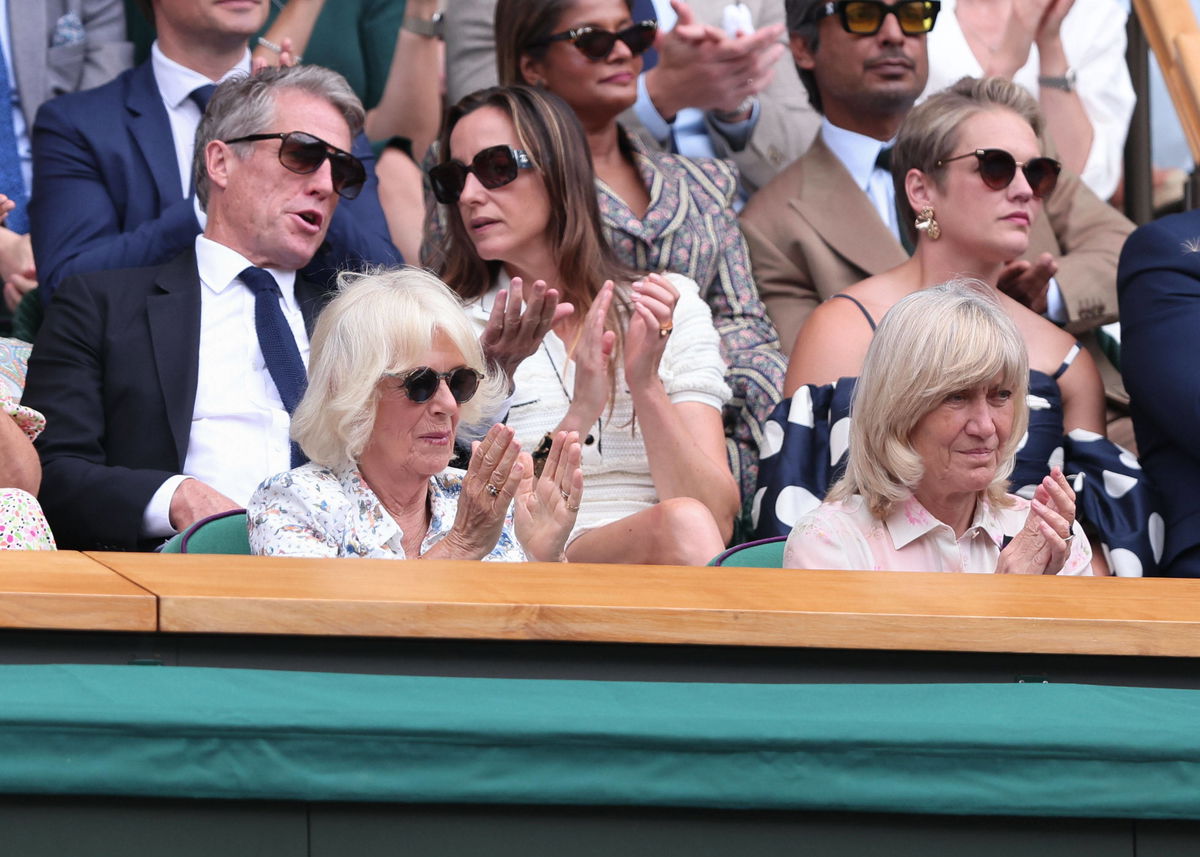
Imago
Wimbledon Feature, L-R.Queen Camilla Deborah, dahinter Schauspieler Hugh Grand und Anna Eberstein, Deborah Jevans AELTC Chair in der Royal Box *** Wimbledon Feature, L R Queen Camilla Deborah, behind her actor Hugh Grand and Anna Eberstein, Deborah Jevans AELTC Chair in the Royal Box Copyright: xJuergenxHasenkopfx

Imago
Wimbledon Feature, L-R.Queen Camilla Deborah, dahinter Schauspieler Hugh Grand und Anna Eberstein, Deborah Jevans AELTC Chair in der Royal Box *** Wimbledon Feature, L R Queen Camilla Deborah, behind her actor Hugh Grand and Anna Eberstein, Deborah Jevans AELTC Chair in the Royal Box Copyright: xJuergenxHasenkopfx
Watch What’s Trending Now!
The timeless elegance, tradition, and grace, Wimbledon is all about celebrating the heritage of tennis. With its all-white dress code, perfectly manicured lawns, and absence of flashy advertising, the tournament stands apart as the most refined event in the sport. And in a world where nearly everything has a price, Wimbledon faced a tempting offer of USD 80 million, perhaps a chance to plaster Centre Court with corporate names.
But, the tournament turned down the staggering offer in potential sponsorship deals that would have allowed corporate names and logos on Centre Court! Why? Maybe to protect its classic image and choose heritage over hype, proving that some things—like charm, history, and prestige—are simply not for sale.
What was the $80 million revenue opportunity Wimbledon turned down?
The most prestigious Grand Slam in tennis not only prioritises its long-standing traditions over commercial gains but also keeps its courts visually clean and its partnerships limited, unlike the US Open or Australian Open, which feature rotating LED billboards and numerous sponsor activations.
Experts estimated that Wimbledon could have generated an additional £50–£100 million (~$60–$120 million) annually had it chosen to open up its courts to more visible sponsorships. However, the All England Club limits its sponsorship deals to a curated group of “official suppliers” who align with the tournament’s image, despite strong global demand from brands. This deliberate restraint means Wimbledon leaves over $60 million a year on the table by not monetizing its courtside spaces and maintaining a highly exclusive sponsor roster.
With the tournament having only 17 sponsors in 2025, far fewer than the Australian Open (40) or Roland Garros and the US Open (30 each), the opportunity was not about a matter of loss but a matter of strategic choice. Upholding a clean, elegant aesthetic is central to its identity, and by doing so, Wimbledon strengthens its brand prestige while aligning with a legacy of class, heritage, and restraint that few events can match.
Why does Wimbledon prioritize tradition over commercial expansion?
Wimbledon has always been a cultural tournament rooted in over a century of tradition. Its identity is built on elegance, restraint, and timeless values that set it apart from the increasingly commercialised world of modern sports. And this is one of the major reasons why the event consistently chose the traditional way over some aggressive revenue generation, even when the financial upside is significant. The All England Club firmly believes in preserving the purity of tennis and the visual beauty of its iconic grass courts. Hence, by limiting the visible sponsorship, it avoids on-court branding and partners only with a carefully selected group of long-standing sponsors.
Unlike the flashy LED boards and cluttered logos seen at other Grand Slams, Wimbledon opts for fixed signage and a clean aesthetic that reflects its premium image. This conscious decision helps maintain the event’s charm, credibility, and global prestige. Moreover, the sponsors at Wimbledon are not just advertisers but brand partners who must align with the tournament’s heritage. Therefore, brands like Rolex, Slazenger, and Ralph Lauren have deep-rooted, years-long associations with the event, and their presence enhances Wimbledon’s sense of tradition rather than diluting it.
One can say that Wimbledon’s strategy is about exclusivity, as it values scarcity and storytelling over saturation. While this means leaving tens of millions of dollars unclaimed each year, the trade-off preserves a legacy that money cannot buy. While the event resists the commercial pressure, it does ensure that its brand remains one of the most respected and desirable in global sport!
How does Wimbledon’s prestige-first strategy affect its global brand and finances?
In case you think Wimbledon’s way of turning down the expanded on-court branding and broader commercial partnerships had been a fault, think again because tennis’s most prestigious Grand Slam still remains highly profitable. Because Wimbledon’s prestige-first strategy strengthens the tournament’s global brand and financial foundation in many powerful ways. While one way is by emphasising exclusivity, tradition, and a clean aesthetic, there are other strategies the tournament has used to build one of the most respected and premium identities in world sport—a brand that transcends tennis itself.
In 2025, Wimbledon reported a total operating revenue of approximately £380–£400 million (~$500 million). A significant portion of this, nearly 50%, came from global broadcast rights. Moreover, Wimbledon’s financial strength is also evident in its investment in the sport since the tournament awarded £53.5 million (~$72.7 million) in prize money in 2025.
While Wimbledon leaves over $60 million annually on the table by refusing mass sponsorships and courtside branding, it gains long-term brand equity. Its selective partnerships enhance its elite image rather than erasing it. This approach positions Wimbledon not just as a sporting event but as a symbol of heritage and excellence. In doing so, the tournament attracts high-value sponsors, premium global audiences, and enduring prestige—all without sacrificing its core identity.
ADVERTISEMENT
ADVERTISEMENT
ADVERTISEMENT
ADVERTISEMENT

